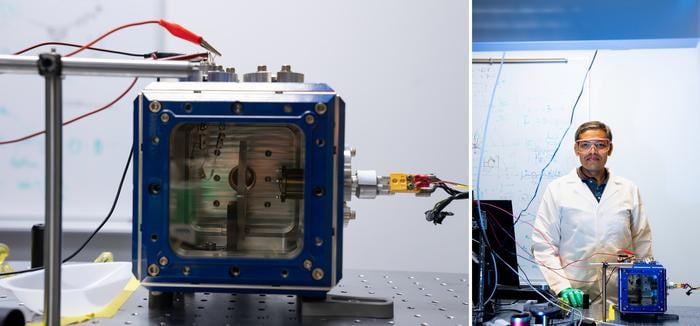Rice University researchers have developed a novel approach to capturing waste heat from industrial processes, potentially saving billions in energy costs. Their quantum-inspired design could help make thermal energy storage a practical alternative to batteries for grid-scale applications.
Published in npj Nanophotonics | Estimated reading time: 5 minutes
In a world where up to half of industrial heat ends up wasted, costing the U.S. economy over $200 billion annually, finding better ways to capture and reuse this energy has become crucial. Now, scientists at Rice University have taken an unconventional path to solving this challenge, drawing inspiration from quantum physics to create a more efficient way to convert heat into electricity.
The breakthrough centers on improving thermophotovoltaic (TPV) systems, which transform heat into electricity through light. The team focused on enhancing the thermal emitter – the component that converts heat into light – achieving efficiency levels above 60% while maintaining practical applicability.
“Using conventional design approaches limits thermal emitters’ design space,” explains Gururaj Naik, associate professor at Rice University. “What you end up with is one of two scenarios: practical, low-performance devices or high-performance emitters that are hard to integrate in real-world applications.”
The team’s innovative design uses a tungsten metal sheet topped with silicon nanocylinders and a thin spacer layer. This arrangement allows the system to precisely control how photons – particles of light – are captured and released, maximizing energy conversion efficiency.
The implications of this advance extend far beyond industrial settings. The technology could make thermal energy storage a viable alternative to lithium-ion batteries for grid-scale applications, particularly where long-term energy storage is needed. It could also find applications in space exploration, potentially powering rovers on Mars.
“If our approach could lead to an increase in efficiency from 2% to 5% in such systems, that would represent a significant boost for missions that rely on efficient power generation in extreme environments,” notes Naik, drawing from his experience working with NASA.
As industries worldwide seek to reduce their environmental impact while maintaining productivity, technologies that can recapture and utilize waste heat become increasingly valuable. This development brings us one step closer to a more energy-efficient industrial future.
Glossary:
- Thermophotovoltaic (TPV) Systems
- Technology that converts heat into electricity by first converting heat into light, which is then captured by photovoltaic cells.
- Thermal Emitter
- Component that transforms heat into light in a TPV system.
- Nanocylinders
- Microscopic cylindrical structures that help control the release of light particles in the system.
What percentage of industrial heat currently goes to waste?
Between 20-50% of industrial heat used in manufacturing processes is wasted.
What efficiency level did the new thermal emitter achieve?
The thermal emitter achieved efficiency levels above 60% while remaining practical for real-world applications.
What are the key components of the new thermal emitter design?
The design uses a tungsten metal sheet, a thin spacer layer, and a network of silicon nanocylinders.
How might this technology benefit space exploration?
It could increase power generation efficiency from 2% to 5% for systems like Mars rovers operating in extreme environments.
Enjoy this story? Subscribe to our newsletter


